КраÑÐ½Ð°Ñ Ð—Ð²ÐµÐ·Ð´Ð° в четверг (Red Star Thursday)
So, we have Flightdeck Friday and now, having taken full leave of our senses, we have determined that following the MAKS 07 series and some others, perhaps there is enough interest (and fodder) out there for a recurring feature on elements of the naval- and air forces of Russia, China and North Korea – and their surrogates (Iran and Syria, for example). For several reasons it won’t be a weekly feature like Flightdeck Fridays as research is a little (OK, a lot) more challenging/time-consuming.
One of the reasons we wanted to do something like this was to bring material from non-traditional (read: non-English language) sources. This means much more original source material in, for example, Russian and your humble scribe’s Russian, to coin a phrase, по-царÑки ÑоÑет. Ergo, translation requires extra time with a dictionary/phrasebook as well as online tools, but we think the net effect is to shed a different light on a topic of interest. Today is a good example of that as we are hip-deep in original source material from the Russian air force for an article we had hoped to publish on the early Soviet design efforts for a long-range, supersonic bomber to replace the Bear – what would morph into the Tu-160. Absent that and to set the stage, so to speak, is this offering on the Tu-4 Bull (first published over on the legacy blog) – the first Soviet long-range bomber that could be considered operationally effective (yes, we know about the Maxim Gorky – the operative word was effective…)
BTW, no promises about Mandarin translations – we will have to rely on the good graces and translation skills of others for those articles.
One final Admin item – we will leave it to you, gentle reader, to pick which of the three banners below to use for these posts, so post your vote in the comments section for either (a), (b) or (c).
– Ваш Скромный ПиÑец
(a)  (b)
(b)  (c)
(c) 
RED BULLS: Of Replication, The B-29 and the Tu-4
Perhaps, though, one of the more infamous examples was the development of the Soviet TU-4 Bull from the American Boeing B-29. In the process of duplication, the technology transfer to the Soviet heavy bomber industry was significant and when combined with a traditional evolutionary process, ultimately resulted in the highly successful TU-95 Bear series.
- On July 29, 1944 Ramp Tramp, a B-29-5-BW serial number 42-6256 that was unable to return to its base after a raid in Manchuria (landed in Vladivostok);
- On November 11, 1944 The General H.H. Arnold Special, serial number 42-6365, that was damaged during a raid against Omura on Kyushu was forced to divert to Vladivostok and;
- On November 21, 1944 Ding How, serial number 42-6358, which also landed in Vladivostok.
and a better known variant regarding interior paint:"A little hole was found on the left wing of the [first] aircraft. No aerodynamics or durability expert had the slightest idead what the hell it was there for. There was no tube or wire attached to it, and there was no equivalent to it on the right wing. The opinion of a commission of experts was that the hole had been bored by a factory drill at the same time as the other holes for the rivets. So what to do? Most probably, the hole had been drilled by mistake, and later no one had bothered to fill it in as it was much too small. The chief designer was aked his opinion. ‘Do the Amercans have it?’ ‘Yes.’ ‘So why the hell are you asking me? Weren’t we ordered to make them identical! Alike as two peas?’ So, for that reason, a very small hole indeed, made with the thinnest possible drill, appeared on the left wing of all Tu-4 strategic bombers…’"
"The scroll tunnel connecting cockpit and rear parts of the bomber was half green and half white, because Boeing run out of one of the color when painting this particular specimen. On the copied aircraft, two thirds was painted chromate green, the aft portion left in white primer. ‘Later, this ratio was included in all the instruction books on how to paint the interior of the bomber’."
Finally, this measure of the paranoia present in Stalinist Russia :
"’What kind of stars should be put on the mass-produced aircraft – white American stars of red Soviet ones? If you put white stars, you risked being shot as an enemy of the people. If you put red, first, it will not be a copy, and second maybe Stalin is planning to use the bombers against America, England or China, and therefore keep the American markings.’ The question went all the way up to Stalin himself: Beria (NKVD chief, in charge of B-29 duplication project) ‘told Stalin about the stars as if it were a funny story and that by the way in which Stalin laughed at the joke, Beria knew unerringly which stars should be used. The last problem was solved and mass-production started…’"
Of the three B-29’s, the General H.H. Arnold Special was disassembled at the Central Aerodrome in Moscow. Ding How was grounded as a reference aircraft and Ramp Tramp remained flyable. Ramp Tramp’s engines were replaced with ASh-73TK’s to make the aircraft more maintainable and it remained in-service for nine years.
To perform the replication, everything, right down to bolts and fasteners, had to be converted from English to metric units. Some immediate problems were addressed, the chief one being the thickness of the aluminum skin. The B-29’s was 1/16th inch which required an impractical 1.5875 millimeter thickness in order to be an exact duplicate, therefore a skin of varying thickness between .8 and 1.8 millimeters was used instead.
However, as closely as everything else was copied, the bugs were copied as well, to include problems with the engines and props that US crews experienced (including an unfortuante tendancy to catch fire and for the electric prop governor to runaway) and other probelms with the landing gear. Crews complained about visibility and distortion problems from the extensive glazing in the nose and the centralized self defense system also proved especially problematic.
The first public display of the TU-4 was Aviation Day, 3 August 1947 when 3 were flown in addition to the TU-70 airliner variant. By 1949 the bugs were pretty well worked out and eventually production of 850 units completed. In toto, 0ver 900 factories and research bureaus were part of the effort, all coordinated with a radio-linked production tracking process instittued by Tupelov. The production processes and technology unlocked combined with indigenous industry effrots (e.g., engines) began a process of evolutionary change that led directly to the TU-95 Bear and in part, the Tu-6 Badger (see illustration below).
In addition to serving in Soviet Long Range Aviation forces, the TU-4 was also put in service with China in both bomber and AEW variant form:
As mentioned and like the Stratocruiser in the US, the TU-4 was also converted to a 70 passenger airliner. The impact of the TU-4 went far beyond its actual capabilties, forcing the USAF into development of a wide-ranging early warning and interceptor system.
Ramp Tramp, like her sister B-29s in USAF markings, served as an airborne launch platform for the Soviet Union’s rocket powered supersonic research aircraft, the Samolet 346. This was the product of a German experimental project called DFS 346. The Soviets reportedly captured the DFS 346 in 1945 and built the Samolet 346 using German scientists and a German test pilot. Reportedly, Ramp Tramp was eventually scrapped sometime in the early 1990’s.
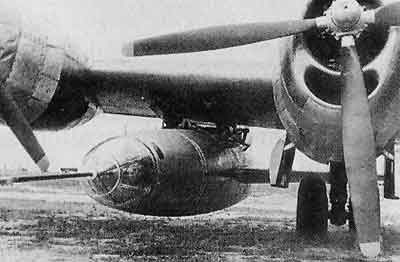
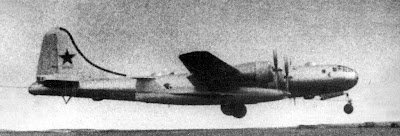
References:
- Monino, Russia Air Force Museum: http://www.moninoaviation.com/39a.html
- Soviet Military Aircraft Design and Procurement, 2nd edition. General Dynamics (Ft Worth division), 1983.
- Russian Aviation FAQ: http://aeroweb.lucia.it/rap/RAFAQ/Tu-4.html



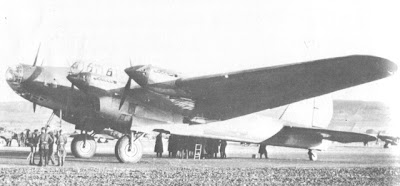
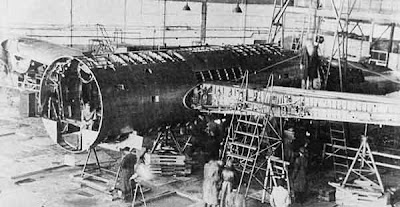

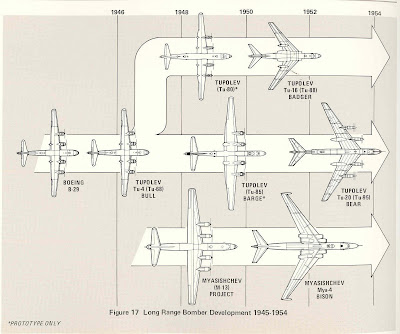

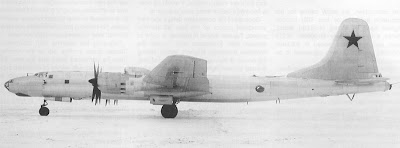

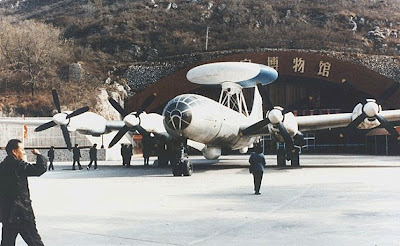

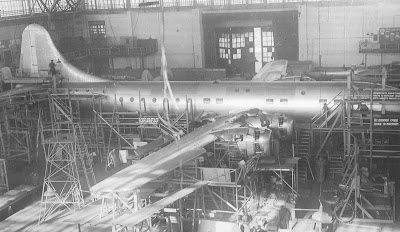
(a) is my vote…it seems to communicate a mindset, as well as the symbol of Communism.
Great jumping off point…
I vote for (a), even though the image probably isn’t all that appropriate for ChiComm or Nork entries in this upcoming series.
And, apropos of nothing, I just happen to have several enameled Soviet military badges that are similar…picked up in a flea market during one of my business trips to Moscow. The Russkies made a LOT of interesting (and kewl) insignia of this sort. Crawling the flea markets for this stuff was a primary diversion during said business trips…and there was a LOT of stuff like this for sale in the mid-90s. Dunno about now.
Buck: A buddy of mine was in Prague not long ago, and that kind of stuff is still all over the place.
You might want to check out this page for some interesting Chinese PLAN stuff: http://www.jeffhead.com/redseadragon/index.htm
-Jeopardy
Seperated at birth: 757 and the Tu-214?
or just stolen from Renton?
I like (a) as well, but concur with Buck in that it’s a little Soviet centric.
And give me a year or two and I can help you out with those Mandarin articles. 😉
I vote for c) or a)
Almost forgot: I vote for c.
I seem to recall that the Soviet’s zeal for an exact copy included making duplicates of battle-damage repairs on one of the 29s that they copied.
This vote is “a”, and concur with the comment of Xformed.
Veritas et Fidelis Semper
P.S. Please excuse the lateness of the vote. Enjoy your weekend, sir.